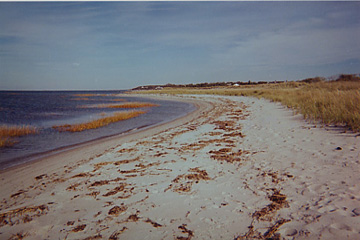

Beaches are the interface between land and sea. They provide habitat for certain plants and animals such as Beach Rose, Dusty Miller, Beach Poppy, Jimson Weed and Sea Rocket. Among the plants and sand grains live tiny animals that birds feed on. Beaches change shape under the pressure and force of the wind and waves. Sand is carried away and new sand is deposited. Winter beaches look different from summer beaches.
Since sea level is rising globally, sand is being blown and washed over the dunes and deposited on the back of the dunes. Gradually the dunes are moving toward the upland. If there is a lagoon or pond between the dune and upland, it will move up on the landward shore, keeping its surface level the same as the sea.
Even so, the line of dunes or barrier beach will continue to protect the lagoon and marsh inland of it, where more fragile plants and animals live.
The estuaries, marshes and lagoons support the animals that feed the larger creatures of the oceans. It is said that eighty percent of the marine animals either begin their lives in estuaries and salt pond or depend for their food on the animals that do. There is a series of barrier beaches along the south coast from Woods Hole to Mashpee, the greatest of which is South Cape Beach. Field trips for birding and coastal studies meet at South Cape Beach where we learn about all of the above and cross over the upland just above the marsh and enjoy Blueberry, Swamp Azalea, Sweet Pepper Bush, Bayberry, and Path Rush. We move into the Pine/Oak forest, enjoy the Inkberry and Poison Ivy, cross a small bog, walk on a dike between marsh and bog, and return to walk the back of the dune finding Horned Larks, Whimbrels, Song Sparrows, Oyster Catchers, Black Ducks and Ospreys.